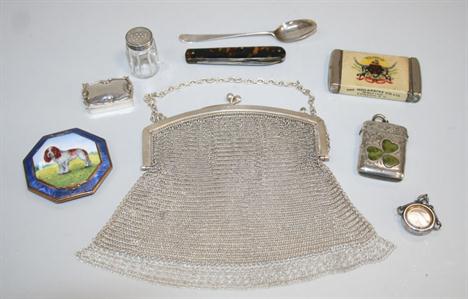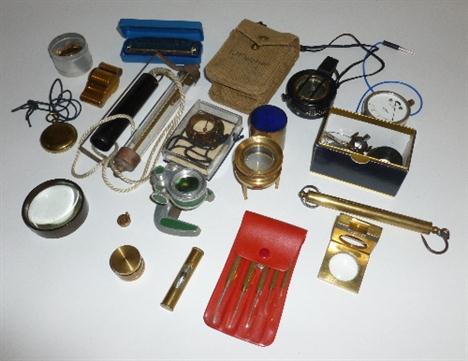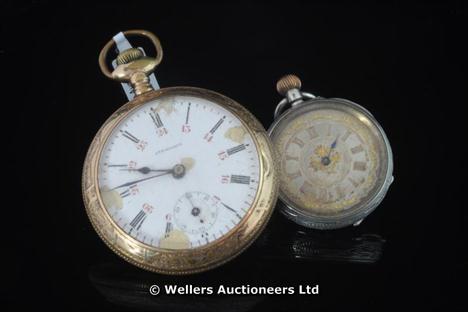36562 Preisdatenbank Los(e) gefunden, die Ihrer Suche entsprechen
36562 Lose gefunden, die zu Ihrer Suche passen. Abonnieren Sie die Preisdatenbank, um sofortigen Zugriff auf alle Dienstleistungen der Preisdatenbank zu haben.
Preisdatenbank abonnieren- Liste
- Galerie
-
36562 Los(e)/Seite
A hide dhal, decorated with impressed circular panels, a wicker parrying shield of angled elliptical form, a heavy circular brass gong, diameter approx 38cm, a pair of Zeiss Telact 8x30 prismatic binoculars, a modern brass compass, impressed `Stanley London`, a pair of spurs, two leather pouches, badges, an Assam sword (dao) with scabbard, a spear, a whip, etc.
A sighting telescope No. 5 Mk II by Pyex Co, Cambridge, dated 1917, together with a tripod by Siemens Bros & Co Ltd, 1916, a Verner`s pattern Mk VII prismatic compass, in its leather case, dated 1915, a further compass, marked `Dennison 1917`, a cast iron model cannon, trench art, a French 75mm shell case, a bomb fragment, etc.
Misc. collectables, including box set containing brass microscope, compass and magnifying glass, two magnifying glasses on stands, one with crocodile grips, a Lensatic Compass in original box, Cenei B slides in original box, wooden dice in case, two dice missing, & a glass eye bath, mixed condition (7 items in total)
A rare silver cased pocket compass with enamel dial. Jesse Ramsden, London, late 18th century. The 1.75 inch circular enamel dial with 36 point rose within band annotated with subdivided cardinal points within outer scale divided for every degree indicated in tenths, with polished steel pointer and in circular case with convex glass, pointer locking lever and suspension loop, the rear engraved Ramsden, London, 5cm (2ins) diameter; with a brass pocket compass, unsigned, late 19th century, with circular silvered dial in moulded brass case with suspension loop, 5cm (2ins) diameter, (2). Jesse Ramsden is recorded in Clifton, Gloria Directory of British Scientific Instrument Makers 1550-1851 as working from several addresses in London 1762 until his death in 1800, however by 1782 both his workshop and principal retail outlet were on Piccadilly. He was one of the finest instrument makers of the period being particularly well known for his invention of a dividing engine and subsequent equatorial telescope stands.
A fine French silver Butterfield pattern sundial. Chapotot, Paris, circa 1700. The elongated octagonal plate with three hour scales for 40, 45 and 50 degrees, the outer IIII-XII-VIII divided into quarter-hours, the inner two 5-12-7 divided into half hours, the centre with engraved vignette of a townscape within curved band signed CHAPOTOT A PARIS with scallop shell and trumpet horn motif above, with glazed four-point compass and hinged bird engraved adjustable gnomen calibrated in degrees for elevation to the outer edge, the underside engraved with latitudes for twenty cities including Londres, Cracouie, Copenhague, Strasbourg, Rome, Madrid, Stokholme, Amsterdam and Hambourg the compass base further decorated with a leafy rosette, 5.8cm (2.25ins) wide; in original leather case with red velvet lined interior applied with a an old label for TESSIERS LTD, LONDON the cover with pique work crown motif within line border, 6.5cm (2.5ins) wide overall. Louis Chapotot worked ‘Sur Le Quay de l’Horloge, Ile de La Cite, A La Sphere, Paris’ circa 1670-1700. He was appointed Master of the ‘Corporation des Fondeurs’ and is thought to have latterly taken his son into partnership who may have subsequently continued the business for a short period during the early years of the 18th century. This type of portable pocket sundial was devised by Michael Butterfield, an English Instrument maker who settled in Paris around 1685. By the end of the century Butterfield’s workshop was also located on the ‘Le Quay de l’Horloge’ hence he would have known Louis Chapotot as a neighbour. The pique work crown to the lid of the case of the current lot appears original and depicts a crown with alternating diamond and lozenge collar beneath rosettes to the coronet. Although very closely related to the Royal Crown, the substitution of rosettes in place of fleur-de-lys to the coronet suggests that the crown belonged to one of the ‘Great Officers of the Crown’, a group of trusted nobles who held the most important administrative offices within the Court. With this in mind it would be reasonable to suggest that the current lot was purchased directly from Chapotot (who was based just around the corner from The Louvre) by an important member of the Royal Court.
A rare James I brass sundial. Inscribed John Robins, dated 1619. The 8.75 inch octagonal plate fitted with scroll decorated angled gnomen set at 51 degrees and centred with a thirty-two point compass rose with stylised sunburst and billowing cloud engraved decoration to segments and annotated NE, SE, SW and NE within the inner track, the middle track engraved N, E, S and W and inscribed Iohn Robins between N and E, the narrow outer track with Roman numeral chapters IIII-XII-VIII divided into quarter-hours as well as eighths, with floating asterisk half hour markers and engraved Anno Cristi *1619* between IIII and VIII, the angles with line engraved border panels and holes drilled for fixing. The engraved detail, octagonal shape and the profile of the original gnomen of the current lot closely conforms to features seen on three related sundials by William Bowyer, Richard Hinton and Isaac Symmes illustrated and discussed in White, George NOT A BAD TIMEKEEPER: THE ENGLISH LANTERN CLOCK IN THE SEVENTEENTH CENTURY (Antiquarian Horology Vol. 31 Sept. 2009 pages 624-8). Indeed the engraved N, E, S and W lettering is so close to those on the Hinton and Symmes dials that it would perhaps be reasonable to suggest that these three dials were engraved by the same hand. The narrow chapter ring, with its asterisk half-hour markers, also closely conforms with those of Bowyer and Hinton Dials and can be compared with the chapter rings applied to the earliest English domestic clocks such as Francis Nowe’s chamber clock of 1588 and the earliest ‘First Period’ lantern clocks made in the Harvey workshops (prior to 1620). The striking similarities between the current lot and the Hinton, Bowyer and Symmes dials is such that it is possible that they were all made for the same purpose in neighbouring workshops. As White suggests that these examples were made by clockmakers to be supplied alongside lantern clocks then it would perhaps be reasonable to suggest that the current lot was also possibly made by a clockmaker for the same purpose. If this is the case then a date of 1619 would place this dial amongst the products of a maker producing some of the earliest lantern clocks. The engraved name ‘Iohn Robins’ has clearly been added by a different hand than the maker of the dial -as indicated by style of the text with its hatched stems and very positioning on the dial. The style of the font (in particular the ‘s’ of ‘Robins’) suggests that this name was added soon after the dial was made and is probably more likely to be the name of the original owner rather than the maker. It is perhaps interesting to note that records indicate that a John Robins bought a farmhouse known as ‘Boddenhams’ from the Manor of Upton St. Leonards, near Gloucester in 1619. This location would certainly be close enough to the latitude 51 degrees North to allow the current lot to give reasonably accurate readings. Please note: The estimate in the printed catalogue is incorrect
A French champlevé enamelled brass combination carriage timepiece with barometer, thermometer and compass. Unsigned, late 19th century. The eight-day single train movement with silvered platform lever escapement and circular silvered Roman numeral chapter ring within a rectangular bird inhabited foliate scroll engraved cobalt blue ground enamelled gilt brass mask, set beside a conforming aneroid barometer with silvered register calibrated in barometric inches and the usual observations within a matching surround and with Fahrenheit scale mercury thermometer between, the bevel-glazed case with elaborate turned and fluted baton ‘T’ shaped handle above circular convex glazed escapement and compass apertures to top and blue enamel ground floral engraved frieze and matching apron panels divided by turned and fluted pilasters projecting at the angles, on turned tapered feet, 15cm (6ins) high; with a faux leather covered protective outer case.
LARGE SUNDERLAND JUG & OVERSIZED MUG - Sunderland Jug in pink lustre with black transfer decoration, A Sailor`s Memory piece, one side with `Box the Compass` riband over rose compass, poem below reads `Heres to the wind that blows, And the Ship that goes, And the Boy that fears no danger, A ship in full Sail, And a fine pleasant gale, And a Girl that loves a Sailor`; the reverse showing the Sunderland cast iron bridge over the River Wear an the poem `Be wise then Christians while you may, For swiftly time is flying, The thoughtless man who laughs to day, To morrow will be dying`.; plus a view of the `High Levell (sic) Bridge, Newcastle on Tyne`, under the spout, 9 3/4" tall, 7 3/4" diam, 10 1/2" spout to handle, loss to lustre at spout, loss to glaze on handle, a few minor inclusions to original glaze on body; PLUS Oversized Mug with view of the River Wear Bridge on one side and a Sailor`s Poem on the other, 4 3/4" tall, 5" diam, 7" wide at handle, wear to pink, hairline to base.
ENGLISH LADIES DESK - Late 19th c Chippendale Style Mahogany Kneehole Desk in diminutive scale, having inlaid rose compass at center of the molded overhanging top with relieved edge, shallow full width drawer over three drawer pedestals, all with beaded edge and brass batwing pulls, recessed cabinet door in kneehole has matching inlaid compass, lock and key, shallow bracket door set above, on molded bracket foot, 32" tall, 32" x 19 1/2", very good condition.
A collection of treen to include a George III boxwood turned lidded box, a Mauchlinware lidded box housing a compass, turned wooden light pull, etc, together with a 19th Century treenware puzzle box and a treenware pill box with paper label inscribed "Wheaton`s Aperient Family Pills Ringwood", together with a set of brass guinea weights
SIMPLE MORSE CODE TAPPER on stained wood base with terminals bears makers label A.M `BuzzerPractice` 6 3/4" (17.1cm) wide A J.S & S IMPROVED OPTHALMASCOPE, A SIMILAR INSTRUMENT IN PLUSH LINED BOX AND A TYPE E2A SMALL `FLOATING` COMPASS TYPE INSTRUMENT/ATTACHMENT in probably military issue grey painted wood box (4)
-
36562 Los(e)/Seite
























































